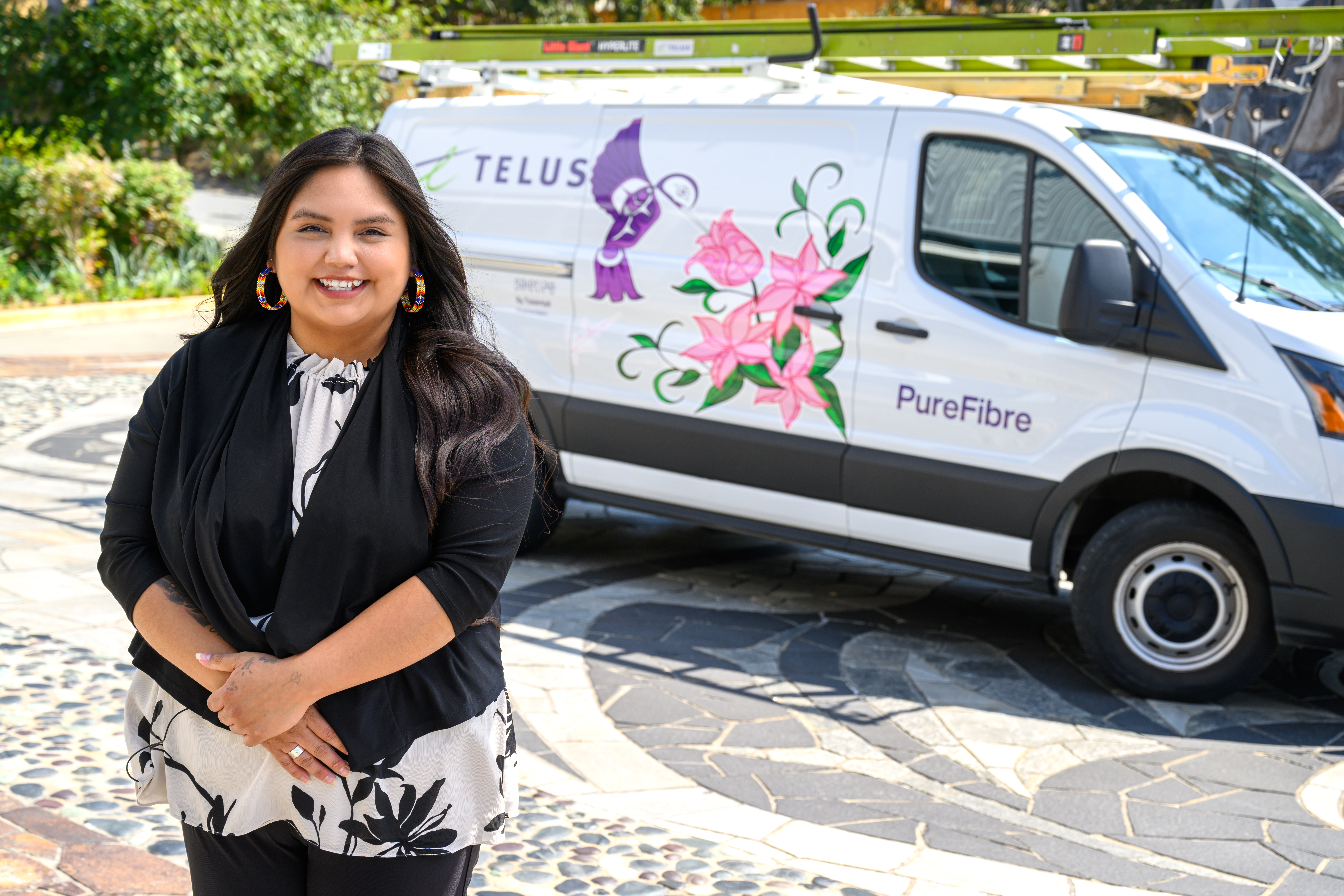
Connecting Canada
5G to revolutionize the classroom with VR, AR and more
May 21, 2021
(Above) The pandemic brought on a mass acceleration of tech by educators and students. The next generation of mobile networks will take that journey farther through immersive, collaborative learning tools. PHOTO BY NICK MENZIES
Over the last year, education in Canada changed radically as the pandemic closed schools and forced students and teachers into virtual classrooms. While COVID ushered in a new era of remote "e-learning" seemingly overnight, the virtual classroom will likely outlast the pandemic.
Thanks to burgeoning new technologies powered by expanding 5G networks, impressive new capabilities are coming to digital and traditional education. Canadians will need to prepare for a whole new type of school, with students working through hybrid in-class and online learning, developing new virtual skills and meeting the challenges new technologies can bring.
TELUS plans to be at the forefront of these changes, both by powering its blazing fast 5G network as well as through various initiatives designed to help make technology more accessible to every Canadian.

Samer Geissah, TELUS' Director of Tech Strategy, spoke with MobileSyrup about how 5G will help education shift into more dynamic experiences that can facilitate better learning. SUBMITTED PHOTO
"With my own kids, [education] is very static. A lot of the work that's being done is simply sharing of documentation back and forth. I think 5G is going to move that forward because a lot of the collaborative online tools will make their way into education," Geissah said.
MobileSyrup also spoke with Sarah Prevette, CEO and founder of Future Design School, which creates resources for and aids schools with creating exceptional learning experiences.
"The pandemic brought on a mass acceleration of technology adoption, which I think is just laying a foundation for the future of education," Prevette said.
As 5G builds on that foundation, Canadian students could soon find themselves with all-new opportunities to learn. However, there needs to be an effort to make sure 5G access helps all students.
5G will enable responsive, virtual learning environments even on low-cost devices
Some people may be inclined to think that, once the pandemic ends, students will go back to traditional classrooms, and school will continue like it did pre-COVID. But that's not the case.
Prevette says technology adopted during the pandemic is here to stay, as are the various tech tools that enable “deep, experiential learning for students.
"I think that sort of digitization is going to continue over the next several years, and we're just scratching the surface in terms of what's possible," she says.
If and when we return to full in-class learning, educators will likely incorporate technology in new ways. Geissah spoke to this, outlining new "engaging and collaborative solutions" such as virtual reality (VR) campuses for attending class in a virtual environment. Unlike the video conferencing calls we use now, VR classrooms may allow for more dynamic interaction by moving away from static, 2D video to 3D digital representations of participants. For example, Microsoft recently showed off its ‘Mesh’ platform for building augmented reality (AR) and VR apps. One of Microsoft’s demos had participants interact in a virtual environment where they were able to talk, gesture and pass digital objects between each other. 5G will be critical to making these types of live, digital interactions seamless through low latency and other benefits.
AR exploration is another great way that 5G could improve educational experiences. Through AR, students can explore things in ways they might not be able to in real life. Google already has a few examples of AR educational tools that are already available. For example, there’s Google’s AR Search function, which lets people look up different animals and view life-sized 3D models through AR. Further, Google’s ‘Arts & Culture’ app lets you take virtual tours of famous museums and cultural sites. Although these tools already exist, 5G will help improve and proliferate them.
5G can help make unique learning experiences like AR and VR more accessible by enabling access for less money. According to Geissah, 5G allows lower-cost devices to participate in complex experiences such as virtual classrooms. A Chromebook on its own, for example, likely wouldn't have the power to run an entire virtual classroom. However, 5G's improved speed, bandwidth and latency allows low-cost devices to leverage cloud processing for intensive tasks and stream results to the device, much in the same way that 5G can improve cloud gaming.
"A lot of the heavy graphical [work] would actually be done on the network side, and because the network is much more responsive, you can use some really basic devices," Geissah explained.
An extension of the virtual classroom could be virtual experimentation. Geissah outlined an example of how students could perform chemistry experiments in a virtual environment to ensure safety while still letting them explore and learn.
More than just VR class, 5G can enable new ways to help students
As cool as virtual classrooms and experiments sound, there are other, more practical ways 5G can help students.
Prevette says that remote learning has put a strain on social and emotional components by disrupting students' ability to have in-person relationships. She envisions a future of "high flex" education that mixes remote learning with in-person time, which should be structured to maximize the mental-wellness component.
At the same time, Prevette outlined how educators can use things like predictive analytics powered by 5G and the cloud to help. Like with the virtual classrooms on low-cost devices, the latency and speed benefits of 5G could allow data to be transferred quickly from student devices to the cloud, where complex predictive analytics programs are able to rapidly check for potential problems in near real-time.
"Imagine a world where the technology can recognize where issues are arising, and then help flag for someone in the system [to] troubleshoot and to intervene before it becomes a much bigger one," Prevette said.
Ultimately, it comes down to what Prevette calls "exceptional learning," which is when kids are engaged, inspired and have the agency to drive their own education.
"Exceptional learning is exceptional learning, regardless of the medium," Prevette said.
Every Canadian will need access
With 5G set to bring significant change to education, wide access to 5G will be key.
"I think the big piece for students is making sure that everybody has access to fast, reliable internet to be able to leverage best-in-class technology and that we create an equal playing field,” Prevette said.
Geissah points to TELUS' efforts to expand its network into more rural and remote regions, noting that its 5G technology is now available in 81 cities and towns across the country and continuously expanding
Geissah also points to TELUS' efforts to keep people connected regardless of their socio-economic status.
For example,
TELUS Internet for Good
partnered with school boards during the pandemic to expand the program to families in need with students in Kindergarten through Grade 12. Internet for Good offers eligible low-income families in B.C., Alberta and Quebec access to low-cost, high-speed internet.There's also the
TELUS Mobility for Good program
, which works to connect youth across Canada transitioning from foster care with a free mobile device and rate plans. "The fact that some of our users are not able to afford [it] should not stop them from getting that service," Geissah said.Government policies have made the digital divide in Canada worse, leaving some communities without optimal internet. Get informed.
Since 2000, TELUS has invested almost $240 billion in network infrastructure, spectrum and operations to enhance the coverage, speed and reliability of its world-class network and connect customers from coast to coast to coast. Geissah believes that all of Canada can be connected by 2025 through the combination of a range of technologies (5G, fixed wireless, fibre, and LEOs [low earth orbit satellites] in the far north) that is enabled by coordinated partnership models and made stronger by federal, provincial and municipal public policy that is focused on outcomes and unleashing both spectrum and funding.
5G will help improve availability
Ultimately, 5G will bring changes to many aspects of Canadian life, including education. From allowing students across larger geographic regions to collaborate and learn together online to creating exciting new opportunities for virtual education, 5G could be a game-changer if leveraged effectively.
"We want to be able to meet each student where they're at and be able to provide the support they need in the moment they need it, and be able to chart a path forward that is unique to them," Prevette said. "I think technology is going to be the backbone of that."
But to get to that vision of personalized, exceptional learning, Canada needs the technology. That means ramping up 5G expansion, spectrum auctions and more.
"5G is the technology that will empower and enable seamless, collaborative education experiences that will provide enabling technologies that will empower new remote and in-class experiences."
Originally published in partnership with MobileSyrup.

Help support connecting communities
Better government policies are needed to ensure better connectivity for Canadians.
Get informed


